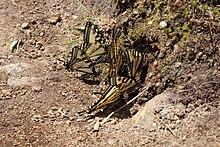Papilio canadensis
This species has also been known to hybridize with both the eastern and western tiger swallowtail, though extremely rarely.
The immature larvae are brown and white to mimic bird droppings, making them unappealing to predators.
Its range extends north of the Arctic Circle in the Yukon, and to Churchill in Manitoba, Little Shagamu River in Ontario, and to Schefferville in Quebec.
It does not occur in southern British Columbia, being replaced there by the western tiger swallowtail, Papilio rutulus, or in some areas of southwestern Ontario, approximately west of Toronto, where it is replaced by the eastern tiger swallowtail.
The caterpillar folds the host plant's leaves and ties them together with silk; they then eat from this structure.

